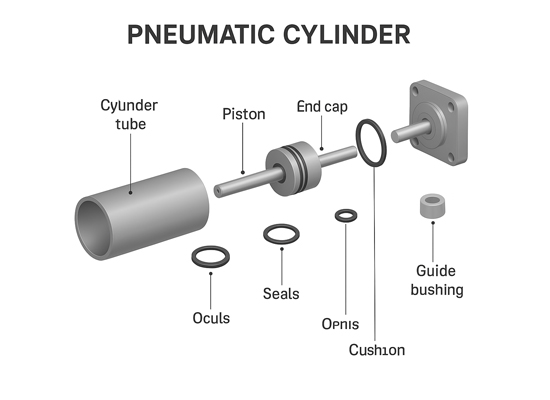Aug 19, 2025
Pneumatic actuator components Include structural components and mounting accessories.The basic components of a cylinder include a cylinder barrel, a piston, a piston rod, a cylinder head, and a sealing device. In addition, it can be equipped with a guide device, a buffer device, and a connecting piece according to the use environment.Mounting accessories include mounting base, front and rear brackets, flanges, cylinder brackets, U-clamps, bearing joints, floating joints, I-joints, etc.
The components and mounting accessories of Fokca cylinders are available for customized manufacturing.
Compact structure and stable pressure resistance
High efficiency in power conversion and precise motion
Long service life and high reliability
Flexible functionality and capability for intelligent integration
The remarkable characteristics of a cylinder are closely related to its constituent components.Next, I will give a detailed introduction to the functions of the components of the cylinder.
Cylinder Tube
The barrel houses the piston and guides its movement. It must be robust and precisely machined to reduce friction and wear. Common materials include aluminum, stainless steel, and brass for corrosion resistance and lightweight properties.
The design of this component affects the cylinder's compact structure and stable pressure-bearing capacity.
Piston
The piston is a disc-like component that separates the cylinder into two chambers. It moves under the influence of compressed air, creating linear motion. Piston materials often include aluminum or steel for strength and durability.
The design of this component affects the cylinder's efficiency in power conversion and motion transmission accuracy.
Piston Rod
The piston rod connects the piston to the external mechanism. It transfers the motion generated by the piston to perform tasks such as lifting or pushing. High-strength steel, often chrome-plated, is used to enhance wear resistance and durability.
The design of this cylinder part affects the efficiency of power conversion and motion transmission. Certain operating conditions may cause the piston rod to rotate, requiring a guide mechanism to prevent rotation.
End Caps
End caps seal the cylinder ends and provide air ports for supply and exhaust. The front cap allows the piston rod to extend, while the rear cap closes the opposite end. They are secured to the barrel with bolts, tie rods, or welding.
The design of this component affects air intake and exhaust. Proper sealing can save air consumption.
Seals
Seals prevent air leakage and ensure smooth operation. Types include piston seals, rod seals, and static seals. Materials like nitrile rubber, polyurethane, and PTFE are common due to their flexibility and wear resistance.
The design of this element affects the cylinder's reliable sealing and service life.
Cushioning
Cushioning components decelerate the piston near the end of its stroke to reduce impact and noise. Adjustable cushioning can improve performance by minimizing shock and vibration.
The design of this cylinder part reduces piston impact during return strokes, decreases wear, and extends piston life.
Guide Rings
Guide rings prevent metal-to-metal contact between the piston and barrel, reducing wear. Made from low-friction, self-lubricating materials such as PTFE, they enhance the cylinder's longevity.
This component mainly contributes to increasing the cylinder's service life.
Tie Rods
Tie rods are threaded rods that hold the cylinder assembly together. They provide structural integrity and are commonly used in industrial cylinders for high-force applications.
The design of this component affects the cylinder's size and pressure capacity, allowing compact designs suitable for limited-space applications requiring certain pressure resistance.
Sensors
Sensors detect the piston's position, enabling precise control in automated systems. Common types include reed switches and Hall-effect sensors for non-contact detection.
The design of this element affects the cylinder's functionality, flexibility, and intelligent integration.

Material selection has a significant impact on cylinder performance and durability:
Aluminum: Lightweight and corrosion-resistant, suitable for general industrial use.
Stainless Steel: Excellent corrosion resistance, ideal for food processing and medical environments.
Brass: Corrosion-resistant, used for small components like fittings.
Sealing Materials: Choose nitrile rubber, polyurethane, or PTFE based on temperature, pressure, and chemical exposure.
Proper maintenance ensures long-term reliability of the cylinder:
Regular Inspection: Check for worn seals, misaligned piston rods, and air leaks.
Lubrication: Use appropriate lubricants for seals and moving parts to minimize friction.
Seal Replacement: Replace seals periodically to maintain airtightness.
Alignment Check: Ensure proper alignment to prevent lateral loads and avoid component damage.
Cylinder maintenance is one way to increase the life of the cylinder. In addition, choosing the correct installation method before the cylinder is put into use can also effectively increase the service life of the cylinder.
The continuous and stable performance of a cylinder relies on proper installation and the correct use of auxiliary accessories. Choosing suitable installation methods and effective accessories can reduce wear, extend service life, and lower failure rates. Browse our article on cylinder installation methods and auxiliary accessories during use.
Cylinder components are replaceable. We provide a wide range of cylinder components to choose from, offering the highest quality products, fastest delivery times, lowest prices, and the most comprehensive product catalog. We are the largest and most professional distributor of cylinders and related components in China. Visit our official website or contact us directly.
You May Interest In
FOKCA ©1998-2025 Fescolo Pneumatic All Rights Reserved Sitemap